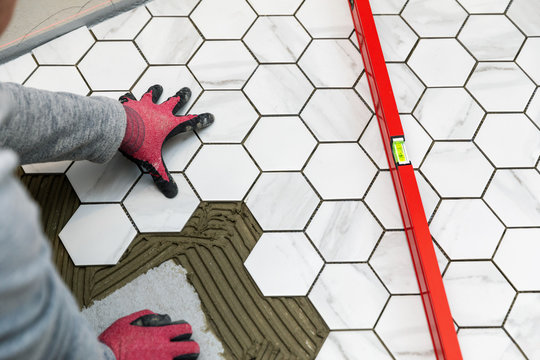Discover the Secrets to Perfect Floor Tile Setup Each Time
Mastering the art of floor tile setup includes a series of specific steps and strategies that, when executed correctly, can result in a refined and smooth coating. By comprehending the keys behind each action, you can guarantee that your ceramic tile installation not only fulfills however surpasses your expectations.
Appropriate Surface Area Prep Work
Effective ceramic tile installment hinges dramatically on careful surface area preparation to make sure a remarkable end result. Before laying ceramic tiles, it is imperative to analyze the substrate's condition extensively. The surface has to be clean, completely dry, and structurally appear to stop future concerns such as loose ceramic tiles or fractured cement. Any existing flooring product, adhesives, or sealants need to be gotten rid of to develop an uniform base for the brand-new ceramic tiles.
To guarantee proper adhesion, it is recommended to rough up smooth surfaces with sanding or scarifying. Furthermore, applying a guide can improve bonding in between the substratum and the ceramic tile adhesive. Irregular surface areas must be leveled using a self-leveling compound to stop lippage and make sure a smooth surface.
In addition, examining for possible resources of wetness is vital, as excess wetness can cause mold growth and damages the floor tiles with time. Making use of a moisture barrier or waterproofing membrane layer in wet locations like bathrooms or cooking areas is essential to shield the floor tiles from water damage. By meticulously preparing the surface before floor tile setup, one can develop a durable and aesthetically appealing tiled location that will stand the examination of time.

Picking the Right Adhesive
Picking the suitable adhesive is a vital action in making certain the successful setup of tiles. The kind of adhesive you select will rely on numerous factors such as the sort of ceramic tile, the substrate product, and the location of the setup. There are various kinds of adhesives available in the market, consisting of thin-set mortar, mastic, and epoxy.

Epoxy adhesives are waterproof and very sturdy, making them perfect for locations vulnerable to moisture such as restrooms or kitchens. They are likewise suitable for installing glass or steel ceramic tiles. When selecting a glue, see to it to comply with the manufacturer's referrals and consider the certain demands of your tile setup task.
Precision Reducing Strategies
One of the most common devices made use of for accuracy cutting in tile installation is the ceramic tile cutter. Floor tile cutters come in numerous kinds, consisting of hand-operated tile cutters, electric damp saws, and portable floor tile cutters. Hands-on floor tile cutters are ideal for straight cuts on ceramic and porcelain floor tiles, providing tidy and exact edges.
In addition, utilizing devices like tile scribes or glass cutters can aid in scoring and breaking floor tiles with accuracy. By grasping these precision reducing strategies, floor tile installers can make sure a professional finish and an aesthetically enticing outcome in their ceramic tile projects.

Cement Application Tips
When transitioning from precision cutting strategies to grout application in tile installation, focus to detail and technique is critical for achieving a remarkable surface. Grout offers not only as a practical element that loads the spaces in between ceramic tiles however also plays a substantial role in the total aesthetic of the setup.
Once the grout is applied, use a damp sponge to clean the ceramic tiles, making certain not to get rid of grout from the joints. Complying with these grout application tips will certainly result in a professionally installed tile surface that enhances the charm of any kind of area.
Completing Touches and Maintenance
To complete the floor tile installment project successfully, focus to information throughout the finishing touches and routine maintenance is critical. After the grout has actually dried out and the tiles are safely in location, the final steps include making certain that all edges are correctly sealed.
Normal maintenance is essential to preserving the appeal and performance of your tiled surface areas. A straightforward regimen of sweeping or vacuuming complied with by mopping with a gentle cleaner can help maintain your ceramic tiles looking pristine (tile installation austin). For locations that are frequently revealed to dampness, such as washrooms or kitchen areas, regular resealing of cement lines is recommended to prevent mold and mildew and mildew development
Conclusion
In verdict, achieving perfect floor tile installment whenever calls for attention to link information and proper methods. By concentrating on surface preparation, choosing the correct adhesive, utilizing accuracy reducing approaches, applying cement very carefully, and completed with interest to information, you can make certain a professional-looking outcome. Bear in mind to comply with these actions and keep your tiles on a regular basis to prolong their life expectancy and keep them looking their finest.
One of the most usual devices utilized for read this precision cutting in ceramic tile installment is the floor tile cutter. Floor tile her latest blog cutters come in various types, including hands-on ceramic tile cutters, electric wet saws, and handheld ceramic tile cutters. Hands-on ceramic tile cutters are appropriate for straight cuts on ceramic and porcelain tiles, supplying accurate and tidy edges. In addition, using tools like tile scribes or glass cutters can help in racking up and breaking floor tiles with accuracy. By mastering these precision cutting techniques, tile installers can guarantee a professional surface and an aesthetically attractive result in their tile tasks.